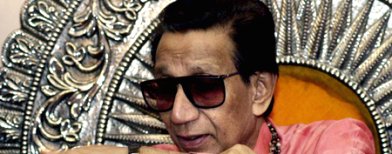November 19, 2012
Mumbai — While the death of Shiv Sena chief Bal Thackeray brings to an end an era of fiery oratory, right-wing views and sons-of-the-soil crusades, the burning question now is: who will take the Sena legacy forward and fill the political void created by his demise?

November 19, 2012
Mumbai — While the death of Shiv Sena chief Bal Thackeray brings to an end an era of fiery oratory, right-wing views and sons-of-the-soil crusades, the burning question now is: who will take the Sena legacy forward and fill the political void created by his demise?

The two obvious contenders – his son Uddhav, mild-mannered and pragmatic; and nephew Raj, charismatic and aggressive – are poles apart, and there is also the possibility of a third, unpredictable outcome.
In his last address to his followers through a video-recorded message, Thackeray appealed to them to 'take care' of Uddhav, who is presently the executive president of the Sena – an indication that his son would be the official heir. But will party workers follow his word?
Raj's exit from the Sena, following a power-tussle with cousin Uddhav, and the formation of the Maharashtra Navnirman Sena (MNS), headed by Raj, had thrown the legacy question into uncertainty. For years before this, Raj, son of Thackeray's younger brother Shrikanth, was seen as his political heir. Raj had been the Sena chief's loyal companion, accompanying him everywhere, picking up his style and mannerisms, and had also headed the Sena's student wing, the Bharatiya Vidyarthi Sena.
According to Sena insiders, the trouble began during the Sena-BJP rule in state, when Raj got embroiled in the murder case of Dadar resident Ramesh Kini, who was killed in an alleged tenant-landlord dispute. Sources said it was during this time that Thackeray began re-thinking the choice of Raj as successor.
When some party seniors, who were not in favour of Raj, got a wind of this, they reportedly started convincing the Sena chief that Uddhav would be the better option. In 2004, Uddhav was made the executive president, intensifying the struggle for power between the cousins, which later culminated in Raj's exit from the party, supporters in tow, in 2006.
With the formation of the MNS, Raj adopted a more aggressive agenda and ate into the Sena vote bank. The impact of this was seen in the 2009 assembly elections, when the Sena-BJP met defeat despite the strong anti-incumbency factor against the Congress-NCP alliance.
Meanwhile, Uddhav was seen piggybacking on the Sena chief, who appealed for votes even in the worse of health. Uddhav even launched his son Aditya as a chief of the Yuva Sena, a youth wing formed to counter Raj's fan following in the younger generation.
"There were two things that defined Thackeray. One, his political style – aggressive and action-oriented on field, and approachable as a politician. The second was his association with the sons of the soil issue. The one who can get closest to this to this will take his legacy forward," said political analyst Surendra Jondhale.
Jondhale, who has been observing the brothers for more than two decades, said that Raj is better placed as far as typical Sena agenda is concerned. "People are yet to identify Uddhav with the Marathi manoos. He has limited people-connect, unlike his father. Raj comes closer to the Thackeray style of politics."
But will that be enough?
When the senior Thackeray picked the Marathi agenda in 1966, the time was ripe, with large-scale unemployment in Mumbai. Things are different today and with the boom in the service sector several Maharashtrians are finding jobs. Even migration to Mumbai has reduced, showing the agenda has a shelf life.
Thackeray himself, in the late 1980s, switched to the larger issue of Hindutva, when he realised that the Marathi agenda was limited to Mumbai. So for the political heir, be it Uddhav or Raj, one thing is certain – they have their task cut out, to find a way of reviving the party, by going beyond the obvious limits.
Courtesy: HT
















































































































